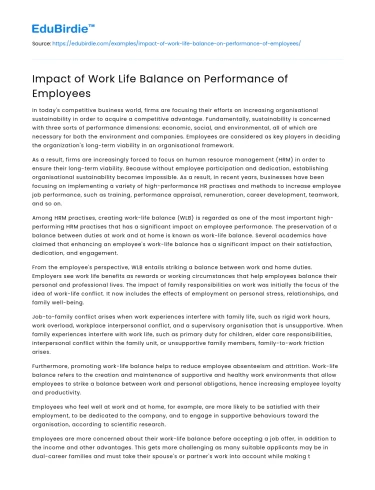In today's competitive business world, firms are focusing their efforts on increasing organisational sustainability in order to acquire a competitive advantage. Fundamentally, sustainability is concerned with three sorts of performance dimensions: economic, social, and environmental, all of which are necessary for both the environment and companies. Employees are considered as key players in deciding the organization's long-term viability in an organisational framework.
As a result, firms are increasingly forced to focus on human resource management (HRM) in order to ensure their long-term viability. Because without employee participation and dedication, establishing organisational sustainability becomes impossible. As a result, in recent years, businesses have been focusing on implementing a variety of high-performance HR practises and methods to increase employee job performance, such as training, performance appraisal, remuneration, career development, teamwork, and so on.
Save your time!
We can take care of your essay
- Proper editing and formatting
- Free revision, title page, and bibliography
- Flexible prices and money-back guarantee
Among HRM practises, creating work-life balance (WLB) is regarded as one of the most important high-performing HRM practises that has a significant impact on employee performance. The preservation of a balance between duties at work and at home is known as work-life balance. Several academics have claimed that enhancing an employee's work-life balance has a significant impact on their satisfaction, dedication, and engagement.
From the employee's perspective, WLB entails striking a balance between work and home duties. Employers see work life benefits as rewards or working circumstances that help employees balance their personal and professional lives. The impact of family responsibilities on work was initially the focus of the idea of work-life conflict. It now includes the effects of employment on personal stress, relationships, and family well-being.
Job-to-family conflict arises when work experiences interfere with family life, such as rigid work hours, work overload, workplace interpersonal conflict, and a supervisory organisation that is unsupportive. When family experiences interfere with work life, such as primary duty for children, elder care responsibilities, interpersonal conflict within the family unit, or unsupportive family members, family-to-work friction arises.
Furthermore, promoting work-life balance helps to reduce employee absenteeism and attrition. Work-life balance refers to the creation and maintenance of supportive and healthy work environments that allow employees to strike a balance between work and personal obligations, hence increasing employee loyalty and productivity.
Employees who feel well at work and at home, for example, are more likely to be satisfied with their employment, to be dedicated to the company, and to engage in supportive behaviours toward the organisation, according to scientific research.
Employees are more concerned about their work-life balance before accepting a job offer, in addition to the income and other advantages. This gets more challenging as many suitable applicants may be in dual-career families and must take their spouse's or partner's work into account while making their own career decisions.
Furthermore, in order to avoid work-life conflict, employees do not express an interest in working in areas other than their home town. Many companies nowadays acknowledge the necessity of cultivating a culture that encourages employees to balance their work and family obligations.
To boost employee performance, businesses attempt to implement work-life balance methods such as flexitime, teleworking, and so on. Furthermore, technological advancements have aided in the transformation of the nature of employment by allowing people to work from a variety of locations, including their own homes.
According to Redmond, Valiulis and Drew (2006) the work-life balance (WLB) as the flexible working environment allows employees to balance personal and employment responsibilities.
As a result, it has become a vital topic that affects both private and public sector workers. Furthermore, WLB balance has a direct impact on a person's social, emotional, psychological, and economic well-being, in addition to their personal life and professional role. All of these issues manifest themselves in a person's productivity, which has an unavoidable impact on employee performance. Employees are a highly valued asset in any organisation. Actively engaging people in enhancing their performance is all it takes to run a productive, successful firm. Hence, based on the preceding logic, it is conceivable to improve employee job performance by improving their work-life balance.






 Stuck on your essay?
Stuck on your essay?

